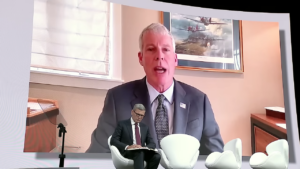Western Australia’s Labor government says it is drawing up plans to facilitate the shift from coal to a grid dominated by renewables, and will develop a “whole of system” plan as well as a strategy to cope with the dramatic uptake of rooftop solar and battery storage.
The plan was unveiled on Wednesday by energy minister Bill Johnston, who said technological change in the energy sector is happening at a rapid pace.
“In Western Australia, we’re blessed with world-class solar and wind resources, abundant gas supply, a wealth of battery metals, and a highly skilled workforce,” he said in a speech to the Institute of Energy.
“We have a genuine opportunity to lead the way in establishing a cleaner, brighter and more resilient energy supply for decades to come. It’s clear that the generation mix will continue to change, so it’s important we have a whole of system approach to plan for the future.
“Put simply, advancement in technology means we can have reliable, affordable power, with lower emissions.”
The W.A. Labor government is not setting its own state-based renewables target, although Johnston has said he endorses the federal Labor target of a 50 per cent renewable energy share by 2030. But he did concede they would likely get there anyway.
“Regardless of policy, WA’s energy system has been changing and is transitioning to a much more renewable and distributed environment,” he said.
Pointing to the graph above, he said renewables, on a business as usual basis, would likely lift their share from 15 per cent now to around 35 per cent by 2030, about the same as coal, “even if we were to overlook the Paris Agreement.”
“If we take a conscientious and sustainable approach, and look at ways of achieving a lower carbon future, by 2030 renewables could generate more than half our electricity – while maintaining sufficient traditional thermal generation to support system security and reliability through this transition.”
The progress of renewable energy in W.A. has been hampered in recent years – first by the former Coalition government that engineered an investment drought, then also by restrictive grid access rules – but is showing signs of rapid growth now.
Three new solar farms have been added to the grid in the past year, and what will be the state’s two biggest wind farms, Warradarge and Yandin – both with capacity factors of 50 per cent or more – are now under construction.
More significantly, the uptake of rooftop solar continues to grow as consumers, both household and business, react to the unwinding of the huge state subsidies that hid the true cost of what was then an almost completely fossil-fuel powered grid.
The subsidy, costing around $500 million a year at its peak, and accounting for more than one third of the costs, has been unwound as the state government looked to shore up the budget as royalties and taxes from the mining industry declined.
Rooftop solar now totals some 1,100MW, making it the state’s biggest generator. In a relatively small isolated grid, this is starting to pose challenges to the grid operator.
“”Put simply, advancement in technology means we can have reliable, affordable power, with lower emissions,” he said.
To facilitate the change, the WA government is proposing a “whole of the system” planning report due for completion in 2020, and a roadmap for distributed energy resources that will be completed by the end of this year.
The DER Roadmap has been prompted by concerns about grid security, and the events of last October when, for the first time, the market operator called in directions to cope with rapid changes in output from both rooftop solar and wind resources.
Johnston said the roadmap would focus on the integration of DER, including onsite generation (mostly rooftop solar), battery storage and energy management systems and, in future other technologies like electric vehicles.
“We are not looking to inhibit connection of rooftop PVs,” Johnston said. “Rather, we aim to produce guidelines, technical requirements and incentives to encourage a more targeted and strategic take up of DER to maximise the benefit to both the consumer and the System as a whole,” he said in the speech.
W.A. has already closed two coal units in Collie, following a botched and highly expensive refurbishment by the previous Coalition government, but it still has several significant coal fired generators in the system, including at Collie – where the local council has rejected cost saving rooftop solar installations because “it would send the wrong message”.
The state’s grid, which with about 18TWh of generation is about one tenth the size of the National Electricity Market, won’t get any more coal fired generators.
Johnston asked for a show of hands from people planning a new private-sector electricity generation project? There were many hands raised. Asked to keep their hands up if there project was for a new coal facility, none did.
“So everyone can see our dilemma,” Johnston said. “Technology has changed and so our ideas must change too.”











